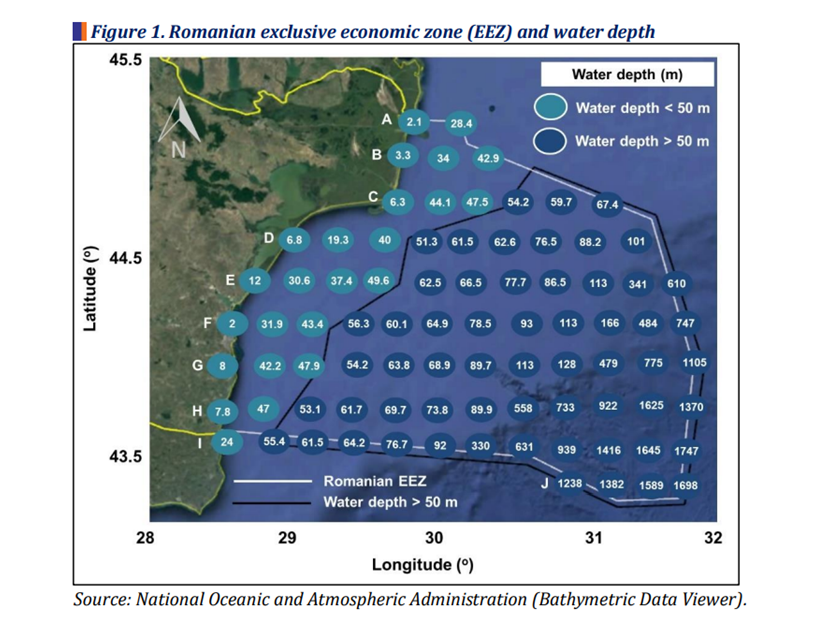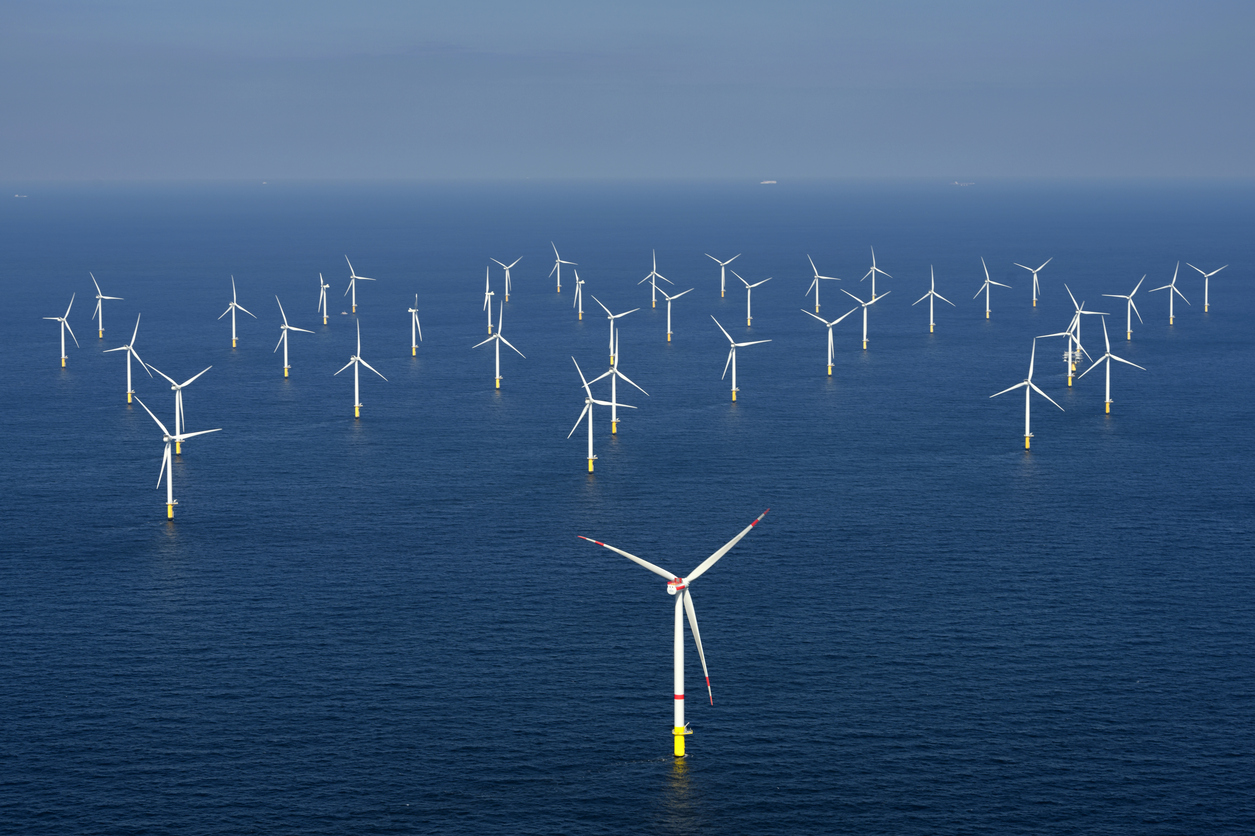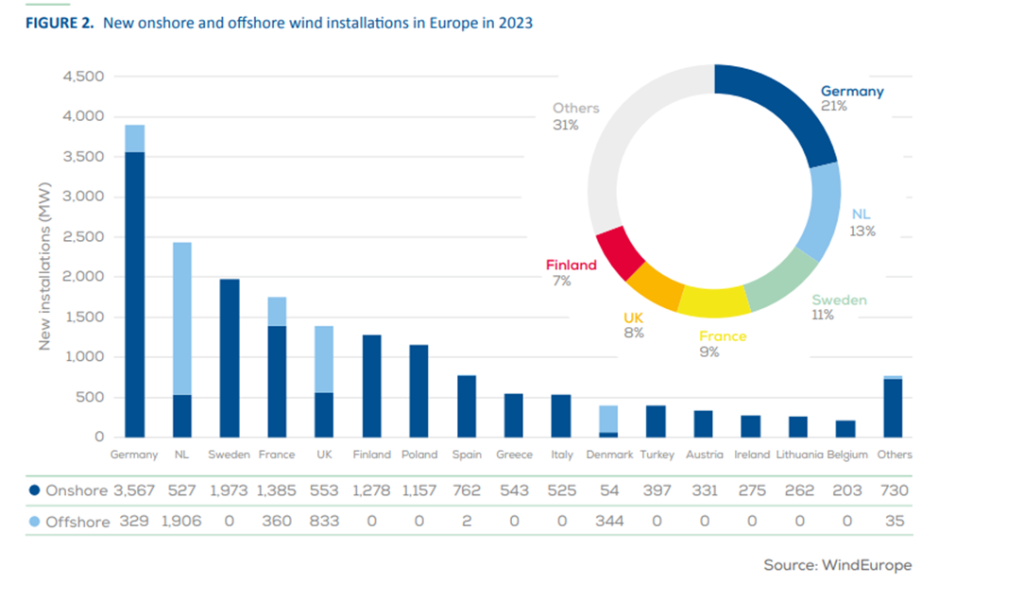Wind energy, both onshore (produced on land), accounting for 92 % of installed wind capacity, and offshore (produced offshore), is already a central pillar of the European energy mix. In 2022, wind farms supplied, on average, 16 % of electricity consumed in the EU and often reaches more than 30 % per day . Large-scale wind energy technologies developed in Europe have become much cheaper in the last 10 years. In many parts of Europe, wind power is the cheapest source of electricity.
Offshore generation reached a record 3.8 GW in Europe. However, optimism about future development is moderate: plans up to 2030 show that 2/3 of the continent's wind generation will continue to be onshore.
Romania has significant potential for offshore energy production in the Black Sea, which needs to be exploited to meet its climate targets and enjoy the economic benefits of this resource.
What are the specific advantages of offshore wind energy?
Offshore wind energy has specific benefits such as: long production interval at full capacity, high number of turbine operating hours, relatively low variability and a high degree of predictability.
What are the economic benefits of offshore wind energy?
Firstly, off-grid wind energy is increasingly a cost-effective source of energy with an impact on the cost of industrial products.
Offshore wind energy can contribute to the development of the hydrogen economy. Electrolytes for hydrogen production are more cost-effective when used consistently. Thus, hydrogen production benefits from being supplied from an energy source that can provide many hours of peak load.
Offshore wind contributes to lower carbon emissions from the power system as well as from industry, contributing to climate transition targets.
What potential does Romania have to develop this type of renewable energy?
World Bank data shows that Romania has an offshore wind potential of 76 GW power installed capacity, benefiting from favourable conditions for the development of this type of renewable energy.
The role of offshore wind energy in the transition is important: in order to reach Romania's climate targets, experts believe that 15GW of offshore wind energy capacity is needed developed in the Black Sea by 2050In other scenarios, offshore wind becomes the largest source of electricity by 2050.
A study by EPG indicated that Romania's natural and technical potential is 94 GW, of which 22 GW can be installed on fixed (shallow) turbines, leading to a production of 239 Twh, of which 54.4 Twh produced by fixed turbines.

Most of Romania's exclusive economic zone has depths exceeding 50m where floating platforms are recommended. Although, due to technological progress, these areas are suitable for the installation of floating turbines, it should be noted that at depths greater than 150m, the cost of mooring increases significantly. In terms of connectivity with the shore power system, more expensive high-voltage systems are required at distances greater than 50m.
What are the big challenges of offshore wind energy production?
First, electricity grid: any wind farm will have to connect to the Dobrogea electricity system, which already incorporates large power generating units. The renewables added over time, as well as the two new reactors at Cernavodă, will lead to a doubling of installed capacity in an area with relatively limited consumption.
Supply chain: In recent years, the supply chain for the wind sector in Europe has been affected by factors such as inflation, access to raw materials, competition from non-European producers and a lack of clarity in the granting of permits. This can lead to long delays: for example, in the case of offshore projects, there can be delays of 3-4 years for the necessary foundation elements. Currently, there are 250 producers in Europe, with new units to be developed in Germany, Poland and the Netherlands.
Approvals: As with other EU countries, urgent action is needed to receive opinions and approvals.
Is there legislation for offshore wind energy?
In March 2024, the Senate debated and approved the draft Offshore Wind Energy Act, which aims to establishing the legal framework for the development of offshore wind energy investments in the Black Sea.
Sebastian Burduja, Minister of Energy, said on this occasion: "At the pace imposed by the draft law approved today in the Government and sent to Parliament for adoption under the emergency procedure, in 2032 we could have the first MW of wind energy produced in the Black Sea in the National Energy System. At the same time, the production of offshore wind energy will allow us to strengthen the Romanian industry through the domestic production of green hydrogen and value-added products based on green ammonia. The draft law adopted today will be debated in Parliament in early February, with the new parliamentary session."
Draft law contributes the achievement of milestone 116, related to Reform 1 - Electricity Market Reform, under Component 6 - Energy of the National Recovery and Resilience Plan.
According to the law passed by the Senate, in order to operationalise investments in offshore wind energy, the Ministry of Energy will start, within 3 months of the law coming into force, a expert study on the basis of which the concession procedure and the exploration, construction and operation of offshore wind power plants will be prepared.
At the latest at the end of June 2025The Government will approve by decision the offshore wind energy fields in the Black Sea that can be concessioned, taking into account the restrictions imposed by environmental protection. The Government will also, within the same period, approve by decision the procedural aspects of the concession of offshore wind energy perimeters, the amount of royalties and the state aid scheme to support investments in offshore wind energy.
What is Romania's current situation compared to the rest of European countries?
At European level, according to the study WindEuropeRomania falls into the "others" category when it comes to installed offshore wind capacity in 2023. Successful examples are Germany, the Netherlands, Sweden, France, UK, Finland, Poland, Spain, Greece.






